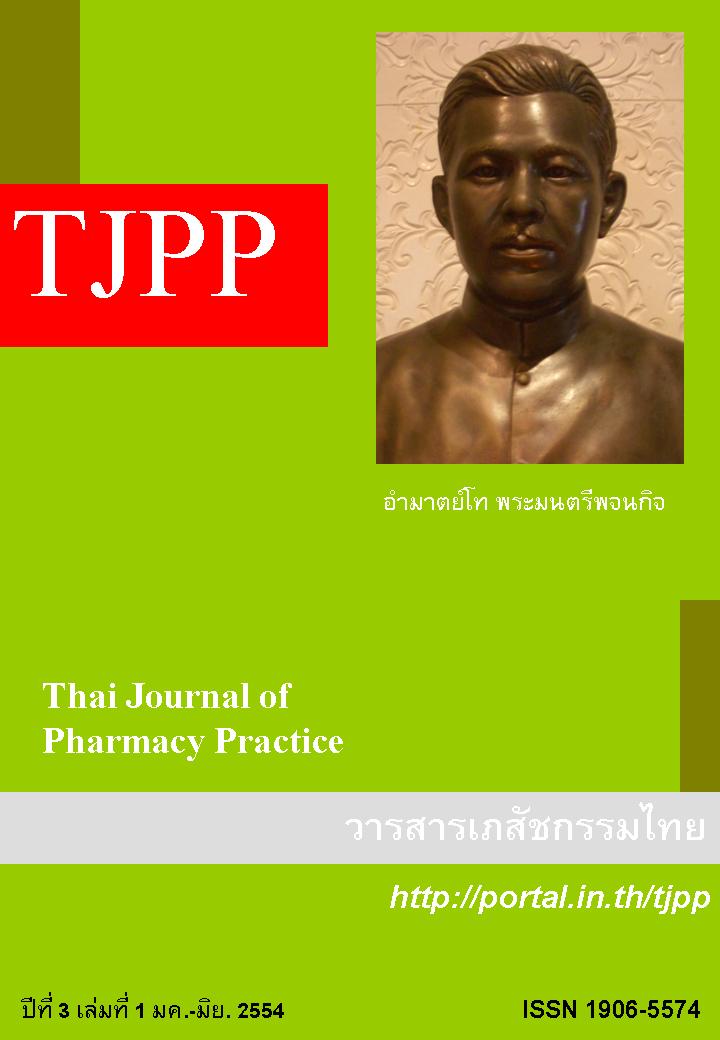ผลของการบริบาลทางเภสัชกรรมในผู้ป่วยนอกโรคปอดอุดกั้นเรื้อรัง
Main Article Content
บทคัดย่อ
วัตถุประสงค์: เพื่อประเมินผลการบริบาลทางเภสัชกรรมต่อจำนวนครั้งการเกิดปัญหาจากยา ความรู้เรื่องโรค ยา และการปฏิบัติตัวของผู้ป่วย และความถูกต้องในการบริหารยาสูดพ่น วิธีวิจัย : การวิจัยเป็นการศึกษาแบบกลุ่มเดียวที่มีการวัดผลก่อนและหลังการแทรกแซง ณ หน่วยบริการผู้ป่วยนอกโรคปอดอุดกั้นเรื้อรังของโรงพยาบาลร้อยเอ็ดและโรงพยาบาลมหาสารคาม ผู้วิจัยติด ตามผู้ป่วยอย่างน้อย 2 ครั้ง ใน 2 หรือ 3 เดือน โดยประเมินปัญหาจากยา ความรู้เรื่องโรค ยาและการปฏิบัติตัว เทคนิคการใช้ยาสูดพ่น และการกลับเข้ารักษาตัวในโรงพยาบาล ผู้วิจัยแก้ไขปัญหาจากยาที่พบ ตลอดจนให้ความรู้เรื่องโรค ยา และการปฏิบัติตัวในประเด็นที่ตัวอย่างยังขาดอยู่ ผลการศึกษา : ผู้เข้าร่วมการศึกษามีทั้งหมด 78 รายและสามารถติดตามประเมินผลได้ครบจำนวน 64 ราย (ร้อยละ 82.1) การวิจัยพบปัญหาจากยาในผู้ป่วย 17 ราย จำนวน 21 ปัญหา ปัญหาที่พบมากที่สุดคือ การไม่ให้ความร่วมมือในการรักษา (ร้อยละ 57.1) การเกิดอาการไม่พึงประสงค์ (ร้อยละ 23.8) การใช้แบบแผนการให้ยาไม่เหมาะสม (ร้อยละ 19.04) หลังให้การบริบาลทางเภสัชกรรมพบว่า จำนวนปัญหาจากยาลดลง จาก 21 ปัญหาเหลือเพียง 1 ปัญหา (p<0.05) ความรู้เรื่องโรค ยา และการปฏิบัติตัวเพิ่มขึ้นจาก 5.16+1.49 เป็น 6.79+1.16 คะแนน(p<0.001) จำนวนผู้ป่วยที่สามารถบริหารยาพ่นสูดรูปแบบ Metered Dose Inhaler และ Accuhaler ได้ถูกต้องทุกขั้นตอนเพิ่มขึ้นจาก 8 รายเป็น 34 ราย และ 6 รายเป็น 17 รายตามลำดับ (p<0.001) สรุป : การบริบาลทางเภสัชกรรมสามารถช่วยให้ค้นหาปัญหาและแก้ไขปัญหาจากยาได้ ทั้งยังทำให้ผู้ป่วยมีความรู้เรื่องโรค ยา และการปฏิบัติตัวดีขึ้น ตลอดจนสามารถบริหารยาพ่นสูดได้ถูกต้องมากขึ้น
Article Details
ผลการวิจัยและความคิดเห็นที่ปรากฏในบทความถือเป็นความคิดเห็นและอยู่ในความรับผิดชอบของผู้นิพนธ์ มิใช่ความเห็นหรือความรับผิดชอบของกองบรรณาธิการ หรือคณะเภสัชศาสตร์ มหาวิทยาลัยสงขลานครินทร์ ทั้งนี้ไม่รวมความผิดพลาดอันเกิดจากการพิมพ์ บทความที่ได้รับการเผยแพร่โดยวารสารเภสัชกรรมไทยถือเป็นสิทธิ์ของวารสารฯ
เอกสารอ้างอิง
2. Lopez AD, Murray CC. The global burden of disease, 1990-2020, Nat Med 1998;4 : 1241-3.
3. National Center for Health Statistics. National health interview survey. [online]. 2001 [cited 2007 Sep 10]. Available from: URL: http: //www.cdc. gov/nchs/nhis.html.
4. Dewan NA, Rafique SL, Kanwar BD. Acute exacerbation of COPD: factor associated with poor treatment outcome. CHEST 2000; 117 : 662-71.
5. Weis KB, Gergen PJ, Hodgson TA. An economic evaluation of COPD in the United State. N Eng J Med 1992; 326 : 862-6.
6. National Heart, Lung, and Blood Institute (NHLBI) and World Health Organization (WHO). Global strategy for the diagnosis, management, and prevention of chronic obstructive pulmonary disease, update [online]. 2004 [cited 2007 Dec 10]. Available from: URL: http://www.nhlbi.nih.gov /nhlbi/ seiin//other/cht-book/html.
7. Chuprapawan J. Health status of Thai people. Research Institute of Public Health, Bangkok. Usa printing 2000. p. 252–60.
8. Burapadaja S, Konkaew P, Tuntipathananandh P, Sanguansermsri J. Effect of clinical practice guideline on therapeutic outcomes and treatment expenditures of COPD patients. CMU Journal 2006; 5 : 77-84.
9. Morris W, Marrero DG, Brewer N, Lykens M, Harris LE, Seshadri R, et al. Effectiveness of pharmacist cares for patients with reactive airway disease. JAMA 2002; 288 : 1594-602.
10. Mehuys E, Boussery K, Adriaens E. Bortel LV, Bolle LD, Tongelen IV, et al. COPD management in primary care: an observational, community pharmacy-based study. Ann Pharmacother 2010; 44 : 257-66
11. Sin DD, Mcalister FA, Pau SF, Anthonisen NR. Contemporary management of chronic obstructive pulmonary disease. JAMA 2003; 290 : 2301-12.
12. Hepler CD, Strand LM. Opportunities and responsibilities in pharmaceutical care. Am J Hos Pharm 1990; 47 : 533-43.
13. Honig EG, Ingram RH. Chronic bronchitis, emphysema and airway obstruction. In: Braunwald E, Faua AS., Kasper DL, Hauser SL, Longo DL, Jameson JL, editors. Harrison’s principle of internal medicine. 15th ed. New York : The McGrawHill Companies; 2001. p.1491-9.
14. Liu SM, Wang XP, Wang DL, Zhou YM, Zheng JP, Zhong JP, et al. Epidemiologic analysis of COPD. Medscape 2005; 85 : 747-52.
15. Department of respiratory and clinical care medicine, Central Middlesex Hospital. Burden of COPD [online]. 2000 [cited 2005 Sep 14]. Available from: URL. http://www.piory.com/ cmol/COPD.html.
16. Roughead EE, Semple SJ, Vitry AI. Pharmaceutical care services: a systematic review of published studies, 1990 to 2003, examining effectiveness in improving patient outcomes. Int J Pharm Pract 2005;13 : 53-70.
17. Phimarn W, Dhammaraj T, Phadungkit M. Outcome of drug counseling of outpatients in chronic obstructive pulmonary disease clinic at Thawangpha hospital. Mahidol University Journal of Pharmaceutical Sciences 2008; 35 : 8-12.
18. วิมลวรรณ พันธุ์เภา สมพงษ์ เจ็งฮั้ว วราพร สุภามูล อรรถการ นาคำ. การจัดการปัญหาที่เกิดเนื่องจากการใช้ยาในผู้ป่วยโรคหืดและโรคปอดอุดกั้นเรื้อรัง: โรงพยาบาลพุทธชินราชพิษณุโลก จังหวัดพิษณุโลก. วารสารมหาวิทยาลัยนเรศวร 2549; 13 : 51-9.
19. สุชัย นิมไพบูลย์วัฒน์. ผลการบริบาลทางเภสัชกรรมในผู้ป่วยโรคปอดอุดกั้นเรื้อรัง ที่คลินิกโรคปอดอุดกั้นเรื้อรังโรงพยาบาลบ้านธิ จังหวัดลำพูน. เอกสารประกอบการประชุมวิชาการ 1/2551 กลุ่มเภสัชกรภาคเหนือ เภสัชกรรมสมาคมแห่งประเทศไทยในพระบรมราชูปถัมภ์. 2551 : 6-9.
20. Matuzewski K, Palangat NF. Noncompliance with drug therapy for chronic obstructive pulmonary disease: a risk factor for hospitalization. Value Health 1999, 2 : 446-51.


